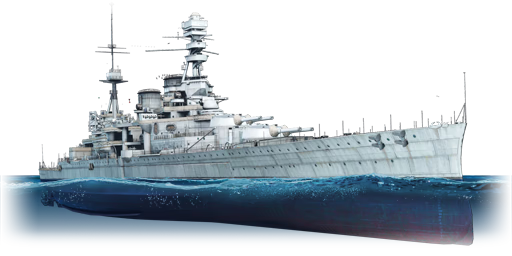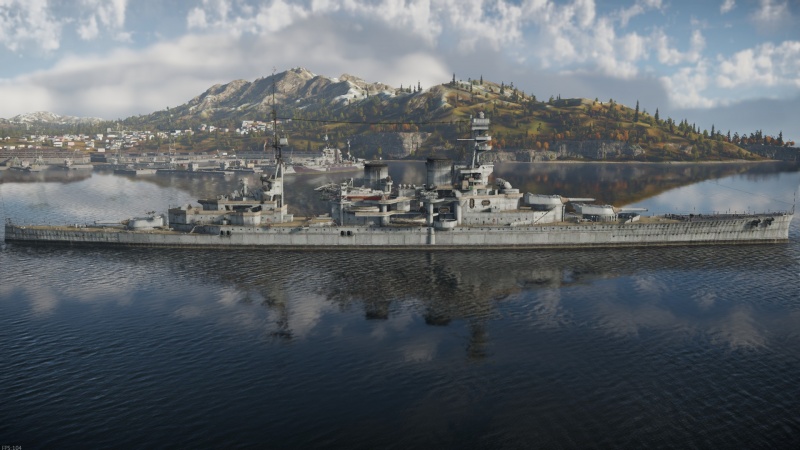HMS Repulse
Contents
Description
HMS Repulse was laid down in January 1915 at John Brown's Clydebank shipyard, launched in January 1916, and commissioned in August 1916. Serving as part of the Grand Fleet during the latter years of the First World War, she participated in the Second Battle of Heligoland Bight in November 1917 and witnessed the surrender of the German High Seas Fleet in November 1918. Following significant refits between 1918 and 1939 to improve armour, armament, and general capabilities, she spent much of the interwar period on peacetime exercises and tours, including escort duties and displays of British naval power. During the Second World War, Repulse patrolled the North Atlantic, participated in the Norwegian Campaign, and later formed part of Force Z alongside HMS Prince of Wales to deter Japanese advances in Southeast Asia. On 10 December 1941, while attempting to intercept Japanese invasion forces near Malaya, Repulse and Prince of Wales were overwhelmed by a concentrated attack from Japanese bombers and torpedo planes, sinking after multiple torpedo strikes. The wreck of Repulse, located in 1959 off the east coast of Malaysia, lies in 54 metres of water and is a designated war grave, though recent reports of illegal salvaging, including the removal of artifacts and unexploded shells, have again drawn international attention to the vessel.
The British battlecruiser Renown-class, HMS Repulse (34), 1941 was introduced in Update "Firebirds" as the second, and last, vessel of her class. Compared to her direct peers, Repulse's main guns offer above-average penetration but low damage output with both AP and SAP shells. While she is relatively resilient to flat-trajectory fire, she is very vulnerable to plunging fire, especially under oblique angles, even from light cruisers. Her mobility is fairly typical for a battlecruiser, making it easier for her to close the gap and approach preferred combat ranges than many other vessels. Overall, she is not the easiest vessel to play, preferring to break contact when under fire (e.g., by using a smoke screen from her floatplane) and targeting enemies that are prone to destruction from magazine explosions.
General info
Survivability and armour
Talk about the vehicle's armour. Note the most well-defended and most vulnerable zones, e.g. the ammo magazine. Evaluate the composition of components and assemblies responsible for movement and manoeuvrability. Evaluate the survivability of the primary and secondary armaments separately. Don't forget to mention the size of the crew, which plays an important role in fleet mechanics. Save tips on preserving survivability for the "Usage in battles" section. If necessary, use a graphical template to show the most well-protected or most vulnerable points in the armour.
Mobility
Write about the ship's mobility. Evaluate its power and manoeuvrability, rudder rerouting speed, stopping speed at full tilt, with its maximum forward and reverse speed.
| Mobility Characteristics | |||
|---|---|---|---|
| Game Mode | Upgrade Status | Maximum Speed (km/h) | |
| Forward | Reverse | ||
| AB | |||
| Upgraded | |||
| RB/SB | |||
| Upgraded | |||
Modifications and economy
Armament
Primary armament
Provide information about the characteristics of the primary armament. Evaluate their efficacy in battle based on their reload speed, ballistics and the capacity of their shells. Add a link to the main article about the weapon: {{main|Weapon name (calibre)}}. Broadly describe the ammunition available for the primary armament, and provide recommendations on how to use it and which ammunition to choose.
| Penetration statistics | |||||||
|---|---|---|---|---|---|---|---|
| Ammunition | Type of warhead |
Penetration @ 0° Angle of Attack (mm) | |||||
| 1,000 m | 2,500 m | 5,000 m | 7,500 m | 10,000 m | 15,000 m | ||
| 4crh CPC | SAPCBC | 487 | 462 | 427 | 399 | 377 | 345 |
| 4crh Mark XIIa APC | APCBC | 644 | 597 | 528 | 470 | 422 | 357 |
| Shell details | ||||||||||||
|---|---|---|---|---|---|---|---|---|---|---|---|---|
| Ammunition | Type of warhead |
Velocity (m/s) |
Projectile mass (kg) |
Fuse delay (s) |
Fuse sensitivity (mm) |
Explosive mass (TNT equivalent) (kg) |
Ricochet | |||||
| 0% | 50% | 100% | ||||||||||
| 4crh CPC | SAPCBC | 752 | 871 | 0.035 | 26 | 58.6 | 48° | 63° | 71° | |||
| 4crh Mark XIIa APC | APCBC | 752 | 871 | 0.025 | 26 | 20.68 | 48° | 63° | 71° | |||
Secondary armament
Some ships are fitted with weapons of various calibres. Secondary armaments are defined as weapons chosen with the control Select secondary weapon. Evaluate the secondary armaments and give advice on how to use them. Describe the ammunition available for the secondary armament. Provide recommendations on how to use them and which ammunition to choose. Remember that any anti-air armament, even heavy calibre weapons, belong in the next section. If there is no secondary armament, remove this section.
| Penetration statistics | |||||||
|---|---|---|---|---|---|---|---|
| Ammunition | Type of warhead |
Penetration @ 0° Angle of Attack (mm) | |||||
| 1,000 m | 2,500 m | 5,000 m | 7,500 m | 10,000 m | 15,000 m | ||
| 4 inch HE | HE | 11 | 11 | 11 | 11 | 11 | 11 |
| 4 inch SAP | SAP | 90 | 72 | 51 | 37 | 28 | 24 |
| Shell details | ||||||||||||
|---|---|---|---|---|---|---|---|---|---|---|---|---|
| Ammunition | Type of warhead |
Velocity (m/s) |
Projectile mass (kg) |
Fuse delay (s) |
Fuse sensitivity (mm) |
Explosive mass (TNT equivalent) (g) |
Ricochet | |||||
| 0% | 50% | 100% | ||||||||||
| 4 inch HE | HE | 805 | 14.06 | 0 | 0.1 | 721 | 79° | 80° | 81° | |||
| 4 inch SAP | SAP | 805 | 15.2 | 0.015 | 5 | 520 | 47° | 60° | 65° | |||
Anti-aircraft armament
An important part of the ship's armament responsible for air defence. Anti-aircraft armament is defined by the weapon chosen with the control Select anti-aircraft weapons. Talk about the ship's anti-air cannons and machine guns, the number of guns and their positions, their effective range, and about their overall effectiveness – including against surface targets. If there are no anti-aircraft armaments, remove this section.
Additional armament
Describe the available additional armaments of the ship: depth charges, mines, torpedoes. Talk about their positions, available ammunition and launch features such as dead zones of torpedoes. If there is no additional armament, remove this section.
Scout plane
Usage in battles
Describe the technique of using this ship, the characteristics of her use in a team and tips on strategy. Abstain from writing an entire guide – don't try to provide a single point of view, but give the reader food for thought. Talk about the most dangerous opponents for this vehicle and provide recommendations on fighting them. If necessary, note the specifics of playing with this vehicle in various modes (AB, RB, SB).
Pros and cons
Summarise and briefly evaluate the vehicle in terms of its characteristics and combat effectiveness. Mark its pros and cons in the bulleted list. Try not to use more than 6 points for each of the characteristics. Avoid using categorical definitions such as "bad", "good" and the like - use substitutions with softer forms such as "inadequate" and "effective".
Pros:
Cons:
History
Describe the history of the creation and combat usage of the ship in more detail than in the introduction. If the historical reference turns out to be too long, take it to a separate article, taking a link to the article about the ship and adding a block "/History" (example: https://wiki.warthunder.com/(Ship-name)/History) and add a link to it here using the main template. Be sure to reference text and sources by using <ref></ref>, as well as adding them at the end of the article with <references />. This section may also include the ship's dev blog entry (if applicable) and the in-game encyclopedia description (under === In-game description ===, also if applicable).
Media
Excellent additions to the article would be video guides, screenshots from the game, and photos.
See also
Links to articles on the War Thunder Wiki that you think will be useful for the reader, for example:
- reference to the series of the ship;
- links to approximate analogues of other nations and research trees.
External links
- [Devblog] HMS Repulse: “Who Touches Me is Broken”!
- [Wikipedia] HMS Repulse (1916)
- [History Of Diving Museum] How a Bottle & Tile from the HMS Repulse Came to Rest on the Ocean Floor
- [Advanced Diver Magazine] Diving into British Naval History HMS Repulse
- [USNI News] Authorities Detain Chinese Ship Suspected of Salvaging U.K. WWII Wrecks
| John Brown & Company | |
|---|---|
| Destroyers | |
| Daring-class | HMS Diamond |
| Light Cruisers | |
| Emerald-class | HMS Enterprise |
| Town-class | HMS Southampton |
| Tiger-class | HMS Tiger |
| Battlecruisers | |
| Renown-class | HMS Repulse |
| Admiral-class | HMS Hood |
| Battleships | |
| Queen Elizabeth-class | HMS Barham |
| Britain battlecruisers | |
|---|---|
| Invincible-class | HMS Invincible |
| HMS Queen Mary* | |
| Renown-class | HMS Renown · HMS Repulse |
| Courageous-class | HMS Glorious |
| Admiral-class | HMS Hood |
| * Unique ship | |





